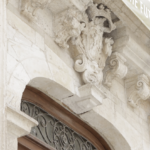Guerrieri Palace
Not far from the port hauls and from the port of Reale, on medieval precincts, the palace of the noble Massa di Brindisi family developed.Ascolta l’audioguida di “Palazzo Guerrieri” di Giacomo Carito
Not far from the port hauls and from the port of Reale, on medieval precincts, the palace of the noble Massa di Brindisi family developed. The availability of Annibale De Leo, son of Vittoria Massa, was arranged, and a reconstruction was arranged which, in the essential lines, gave the main aspect, on the eighteenth-century decline, the current appearance. Hermann Broch wrote that “architecture is the testimony of man’s aspiration to conquer time by raising order in space” and perhaps this was in the intentions of the learned archbishop. The theme of the door-keeper columns is taken up in the portal where the emblem refers to both the Mass and the De Leo. After being before the baroness Claudia Bottari of Francavilla Fontana and then Raffaele Monticelli-Cuggiò, 1851 was acquired by Vito Guerrieri, whose heirs made the 1872 assignment to the City of Brindisi that will use it for training courses. On the ground floor there were the service structures, while on the first floor there were the rooms destined for the residence, which did not lack a chapel. The palace garden will be eliminated to give rise to a gym. Remarkable was the partially walled ogival arch that probably gave access to port warehouses or warehouses. Roman and medieval walls, evidence of the invisible cities that in space and time were denied to give rise to the current, were found during excavation campaigns conducted in the gym area.
Ascolta l’audioguida di “Palazzo Guerrieri” di Giacomo Carito
Not far from the port hauls and from the port of Reale, on medieval precincts, the palace of the noble Massa di Brindisi family developed. The availability of Annibale De Leo, son of Vittoria Massa, was arranged, and a reconstruction was arranged which, in the essential lines, gave the main aspect, on the eighteenth-century decline, the current appearance. Hermann Broch wrote that “architecture is the testimony of man’s aspiration to conquer time by raising order in space” and perhaps this was in the intentions of the learned archbishop. The theme of the door-keeper columns is taken up in the portal where the emblem refers to both the Mass and the De Leo. After being before the baroness Claudia Bottari of Francavilla Fontana and then Raffaele Monticelli-Cuggiò, 1851 was acquired by Vito Guerrieri, whose heirs made the 1872 assignment to the City of Brindisi that will use it for training courses. On the ground floor there were the service structures, while on the first floor there were the rooms destined for the residence, which did not lack a chapel. The palace garden will be eliminated to give rise to a gym. Remarkable was the partially walled ogival arch that probably gave access to port warehouses or warehouses. Roman and medieval walls, evidence of the invisible cities that in space and time were denied to give rise to the current, were found during excavation campaigns conducted in the gym area.


